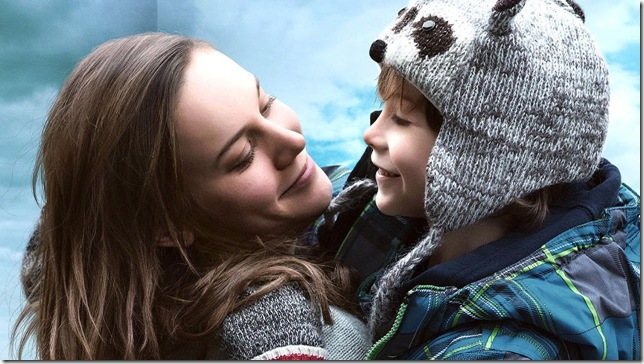There’s something inherently limiting about the movie screen that makes cinema a more claustrophobic medium than theatre. In theatrical sets, doors suggest a world beyond the confined drama, providing an escape from the demons, the embarrassments, the high jinks. Even if the characters don’t use them, it’s comforting to know they’re there.
Movie screens, on the other hand are inescapable rooms, imprisoning characters within the four walls of a two-dimensional rectangle. Many directors work against these strictures, obliterating the walls through atmosphere, 3D photography, camera movement and editing, but there’s a back-to-zero purity in the way director Lenny Abrahamson embraces the limitations of his canvas in Room.
Adapting Emma Donoghue’s 2010 best-seller of the same name, Abrahamson’s film is, at least at first, a careful study in deprivation, immersing viewers into a four-walled interior so constricting that we become no different than the mouse that shows up 15 minutes into the movie, unaware of what the room is or why it’s here.
The room has two occupants: a young woman of maybe 21 (Brie Larson), acne-scarred, pale and perpetually exhausted; and her androgynous son Jack (Jacob Tremblay), a piercing sparkplug of Amazonian hair.
Every item in the room is grimy, the paint peeling, the commode missing its top, the kitchen stocked with grilled cheese and cereal and not much else. A skylight provides the only evidence of the outside world, and exercise is achieved by running the few feet from one side of the room to the other. Jack has no toys and a crappy old boxy television; he entertains himself by fingering rug fibers.
A visitor of apparent familiarity (Sean Bridgers) appears regularly to restock the room’s squalid provisions, and he sleeps with the mother. Significantly, we first encounter him without his pants, through the slits in a cramped closet nook, where Jack is kept when the man shows up.
We don’t see people like this in the movies, or even in real life. Most viewers will ask themselves questions during this mysterious overture of restriction, and answer in judgment: What kind of a mother would provide this kind of life for her son? Is she prostituting herself? Is she mentally ill? Who are, as Jerry Seinfeld existentially posed, these people?
Abrahamson and screenwriter Donoghue, who adapted her book, reveal the answers, and when they do, all judgment will cease, or turn to shame. It’s one of the great revelations in recent cinematic history, in fact, and those interested in experiencing the full power of Room should see the film before reading the rest of this review.
So consider this your spoiler alert.
We learn, when Jack does, that his mother is an abductee. She was captured by the male visitor, whom she calls Old Nick, seven years earlier. She birthed and raised Jack in captivity, shielding him from any knowledge of an outside world. They live in a shed with a bolted door, and only Old Nick knows the code. The story begins on Jack’s fifth birthday, a time in which he’s finally old enough, his mom says, to know the truth — and to attempt a harrowing escape.
Room achieves its dramatic crescendo after only about 45 minutes, and it’s a sequence of heart-stopping tension that hugs the border between the agonizing and euphoric. The rest of the film — about half — is calmer, if you concede that post-traumatic stress disorder is calmer than the physical trauma itself.
But these scenes, set in comfortable, hushed domesticity, are no less important to the themes that are central to Room’s fragile backbone: healing, coping and the eternal connection between mother and child. For Jack, the transition is more profound than his mother’s. He is a butterfly emerging from a five-year cocoon; everything from the sun’s glare to the stairs of a house to his kindly grandmother (Joan Allen) is new and scary.
Abrahamson continues to filter reality through Jack’s naïve point of view, finding fragmentary confusion in everyday movements and interactions. Early in the film, Jack reads Alice’s Adventures in Wonderland, an allusion that’s a bit on the nose, but it works. Real life becomes his rabbit hole, perplexing and difficult to navigate. As Room moves along, Abrahamson, who previously directed the wonderfully strange Frank, could have trusted his audience more this time around, particularly in his crutch-like reliance on a manipulative score that prevents the emotional rawness of certain scenes from speaking for themselves. But it’s a small quibble for a movie that understands the physical, emotional and psychic tolls of abduction — for the victims’ family as much as the victims themselves — better than any I’ve seen.
Larson is an early front-runner for a Best Actress Academy Award, and she invests blood, sweat and tears in the part — she could have shed 10 pounds just in releasing the latter. Her performance is studied but not calculated, and it would be the main acting takeaway were it not for Tremblay, a 9-year-old thespian of boundless potential, whose naked sense of innocence lost and, perhaps, regained, captures the movie’s soul. Larson will surely get a nod, but here’s hoping the Academy can find room for one more.
ROOM. Director: Lenny Abrahamson; Cast: Brie Larson, Jacob Tremblay, Joan Allen, Sean Bridgers, Tom McCamus, William H. Macy; Distributor: A24; Rating: R. Now playing at Coral Gables Art Cinema; opens Nov. 13 at Cinemark Palace 20, Living Room Theaters and Regal Shadowood 16 in Boca Raton; Cinemark Parisian 20 in West Palm Beach; Downtown at the Mall 16 in Palm Beach Gardens; the Gateway 4 in Fort Lauderdale, and other theaters.
